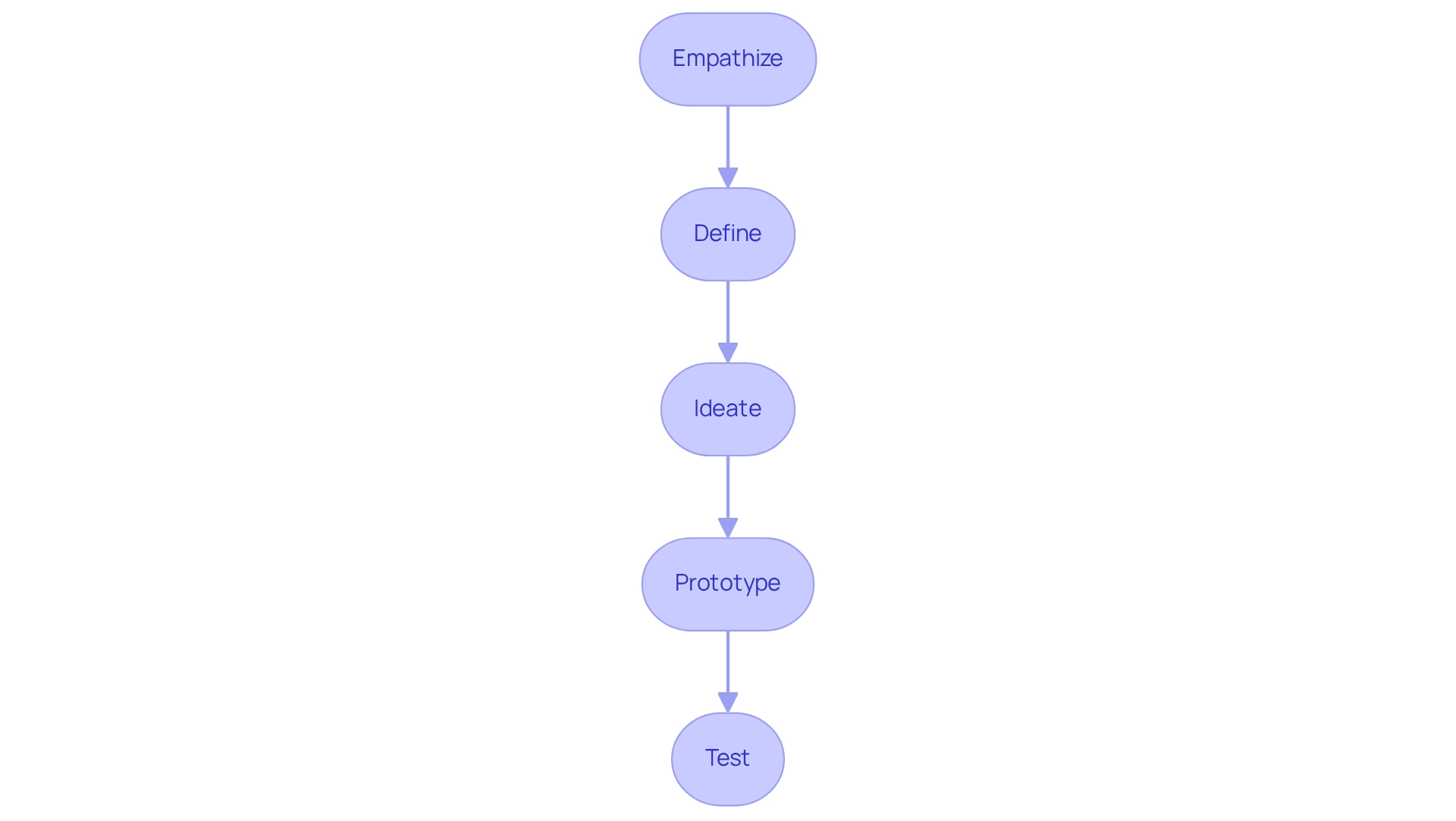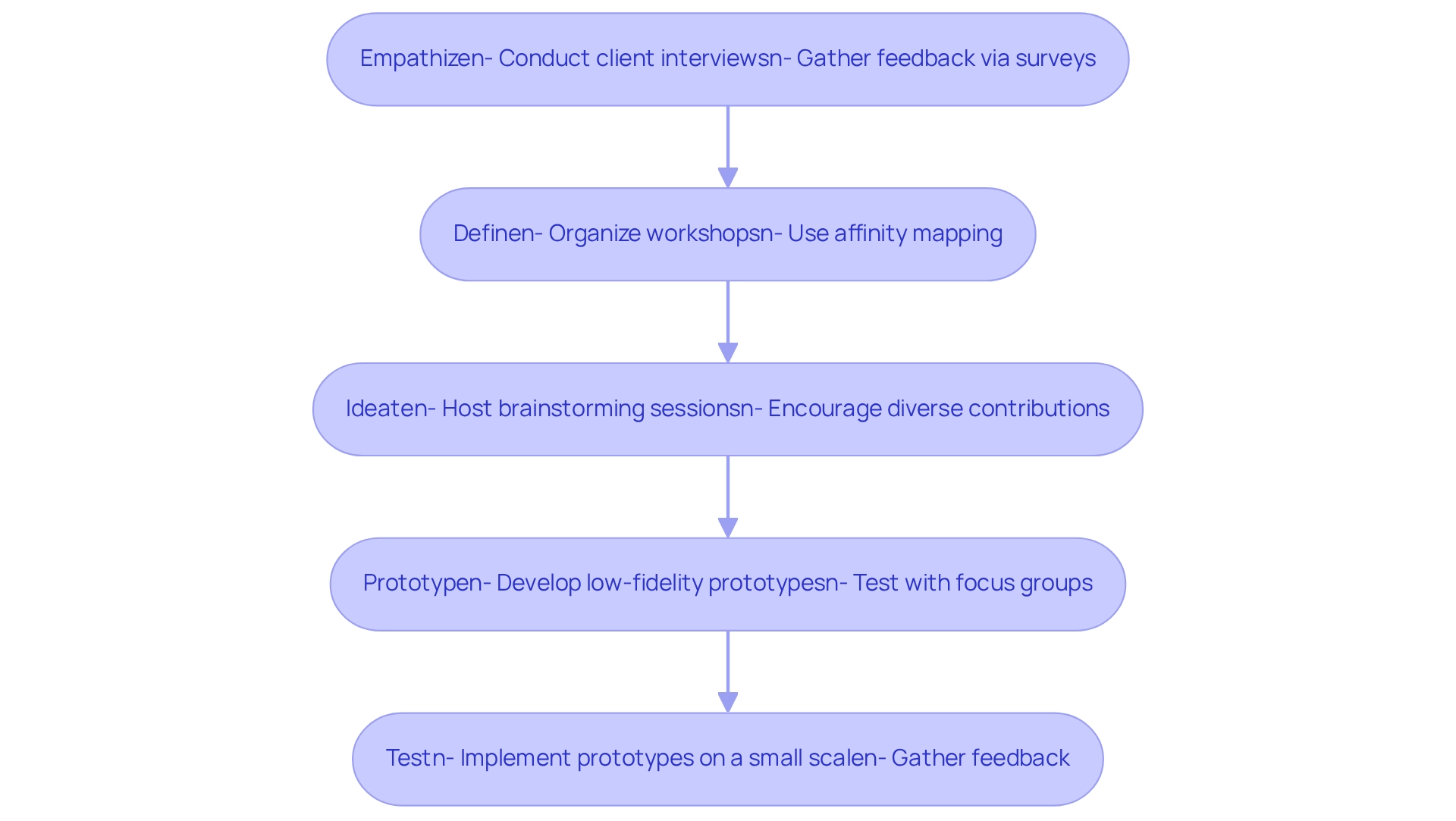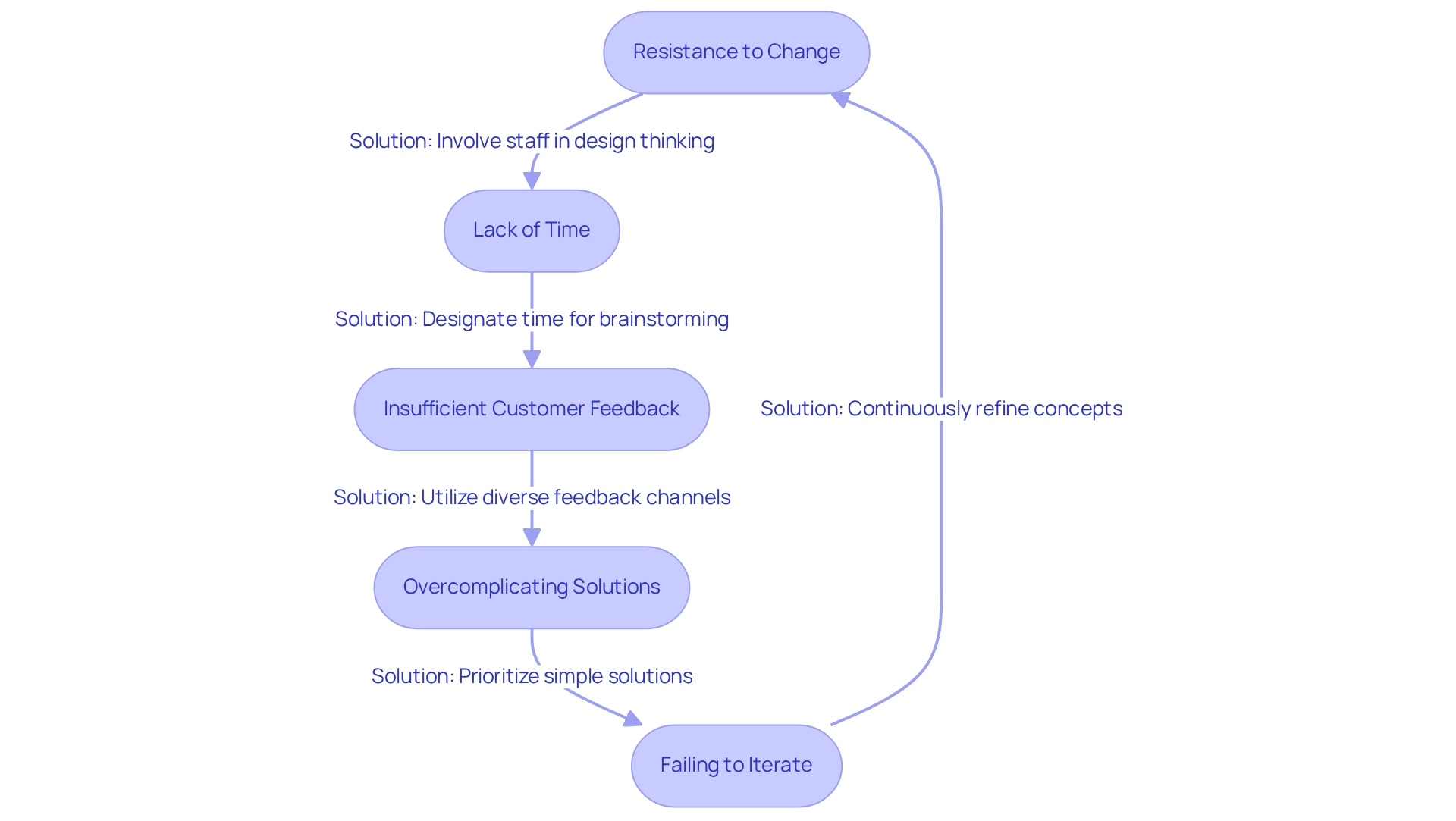General
Master the 5 Phases of Design Thinking for Restaurants in the UAE
Overview
This article examines the five phases of design thinking—Empathize, Define, Ideate, Prototype, and Test—as critical methodologies for enhancing restaurant strategies within the UAE. By rigorously applying these phases, restaurants can significantly deepen their understanding of customer needs, foster innovative solutions, and ultimately craft unforgettable dining experiences tailored to the ever-evolving consumer preferences that characterize a competitive market.
Introduction
In the fiercely competitive restaurant industry, where customer expectations reach unprecedented heights, the application of design thinking stands out as a formidable tool for innovation. This human-centered approach to problem-solving prioritizes understanding the dining experience from the customer’s perspective, empowering restaurants to craft memorable moments that transcend mere food service.
By navigating through the five essential phases of design thinking—empathizing, defining, ideating, prototyping, and testing—establishments can refine their strategies and significantly enhance customer satisfaction.
As the culinary landscape continues to evolve, particularly with the growing demand for healthier and plant-based options, embracing design thinking not only addresses current consumer preferences but also lays the groundwork for sustainable success in the hospitality sector.
Understand Design Thinking in the Restaurant Context
Design methodology represents a human-centered approach to problem-solving, prioritizing the understanding of user needs and experiences. In the dining sector, this translates to a focus on the eating experience from the patron’s perspective. The creative problem-solving process encompasses five essential stages:
- Understanding clients
- Identifying their requirements
- Generating possible solutions
- Creating models
- Evaluating them in practical situations.
In the UAE’s competitive dining landscape, where client expectations are notably high, applying the five phases of design thinking can foster innovative eating experiences that cater to a diverse audience. Recent research indicates that integrating both aesthetic and management perspectives can enhance the effectiveness of creative problem-solving, particularly in addressing limitations that may arise during execution. Notably, cluster analysis has identified these five phases of design thinking for restaurants in the UAE, which can be leveraged to refine restaurant strategies.
For instance, WonderEight’s digital marketing strategy for Quaker Oats exemplifies how a well-executed innovation thinking approach can significantly boost client engagement and sales. This initiative not only elevated Quaker Oats’ online presence but also solidified its position in the health food market, demonstrating the tangible advantages of a customer-centric strategy. Moreover, as consumer preferences shift towards healthier and plant-based options, effective communication and media planning become essential in adapting advertising strategies to reflect these trends.
Furthermore, the importance of human-focused design in dining experiences cannot be overstated. Recent studies emphasize that understanding consumer preferences and behaviors is crucial for creating memorable dining experiences that cultivate loyalty. Tien-Cheng Han notes that ‘novelty seeking boosts the perceived coolness–customer inspiration connection,’ underscoring the value of innovative experiences in the dining sector.
By adopting creative approaches, eateries can transform their offerings into engaging experiences that transcend mere food provision, ultimately enhancing customer satisfaction and driving business success. Additionally, recent trends in the UAE reveal a rising interest in plant-based food options, as highlighted in the International Journal of Hospitality Management, further emphasizing the necessity for restaurants to align their strategies with evolving consumer preferences.

Explore the Five Phases of Design Thinking
The structured approach of the design thinking process encompasses five essential phases tailored for restaurants in the UAE: Empathize, Define, Ideate, Prototype, and Test.
Empathize: This phase underscores the importance of understanding your clients’ needs and experiences through direct observation and engagement. Conducting surveys or interviews with diners can yield invaluable insights into their preferences and pain points.
For instance, recent data indicates that 36% of diners rarely make reservations, while 54% would be deterred by a wait time exceeding 30 minutes. This highlights potential areas for enhancement in engagement strategies. Furthermore, leveraging business intelligence platforms can assist restaurants in analyzing patron data more effectively, offering deeper insights into preferences and behaviors.
Define: Following the gathering of insights, the next step is to articulate the core problem you aim to resolve. If feedback reveals that patrons find the ambiance lacking, this should be clearly identified as a critical issue to address in your design approach. Combining various data sources can also aid in pinpointing labor productivity and sales efficiency issues, thereby refining the problem definition.
Ideate: In this brainstorming phase, generate a broad spectrum of ideas and solutions to the defined problem. Encourage creativity and explore innovative approaches such as unique themes, menu enhancements, or service improvements. This phase is pivotal for cultivating an environment where out-of-the-box thinking can flourish.
Prototype: Develop tangible representations of your ideas, which may include mock-ups of new menu layouts or redesigned dining spaces. Prototyping enables you to visualize concepts and assess their feasibility prior to large-scale execution, ensuring that your ideas are practical and aligned with client expectations.
Test: Finally, gather feedback on your prototypes from actual users. This phase is crucial for refining your concepts and ensuring they resonate with your target audience. Engaging with customers during this stage can lead to insights that significantly enhance the final product, ultimately driving customer satisfaction and loyalty. By effectively navigating the five phases of design thinking for restaurants in the UAE, food and beverage businesses can craft compelling dining experiences that not only meet but exceed customer expectations. As Ray Delucci observes, the success rate for long-term stability in eateries is approximately 20%, underscoring the significance of efficient conceptualization in achieving lasting success.

Implement Each Phase in Your Restaurant Strategy
To effectively implement design thinking in your restaurant strategy, it is crucial to follow these essential steps:
-
Empathize: Initiate the process by conducting client interviews and gathering feedback through comment cards or digital surveys. This information is vital for developing client personas that accurately depict your target audience, enabling tailored marketing strategies.
-
Define: Organize a workshop with your team to discuss the insights gathered. Employ techniques like affinity mapping to identify common themes and prioritize the most pressing issues. This collaborative effort ensures that all voices are heard, fostering a sense of ownership among team members.
-
Ideate: Host brainstorming sessions with your staff to generate innovative ideas. Encourage contributions from all team members, as diverse perspectives can lead to unique solutions. Techniques such as mind mapping can help visualize connections between ideas, enhancing creativity.
-
Prototype: Develop low-fidelity prototypes of your ideas. For instance, if contemplating a new menu, create a sample layout and test it with a focus group of loyal clients. This step allows you to gather valuable feedback before making significant changes.
-
Test: Implement your prototypes on a small scale, such as through a limited-time menu or a pop-up event. Gather feedback and examine client reactions to refine your offerings prior to a complete launch. This iterative process is essential for ensuring that your final product resonates with your audience.
By embracing these measures, eateries can effectively utilize the five phases of design thinking to overcome the challenges of applying creative approaches, ultimately resulting in enhanced client satisfaction and loyalty. Notably, effective strategies, like those employed in the promotional effort for Quaker Oats, demonstrate how creative branding and customer engagement methods, grounded in fundamental principles, can yield quantifiable results. Furthermore, with only 20% of leaders believing their teams are high-achieving, this statistic underscores the importance of efficient collaboration in addressing the challenges associated with implementing innovative concepts in dining establishments.
As Natalia Rossingol aptly states, “Not utilizing decision-making models, you’re leaving your future to chance,” highlighting the critical role of structured decision-making in the creative process.

Troubleshoot Common Challenges in Design Thinking Implementation
Applying creative problem-solving in dining establishments presents various challenges that require strategic interventions. Addressing these issues not only enhances the five phases of design thinking for restaurants in the UAE but also fosters improved employee engagement and service performance, ultimately leading to better financial outcomes for the restaurant.
-
Resistance to Change: Staff may show reluctance to embrace new processes. In 2023, only 43% of employees reported that their organization is adept at managing change, underscoring the necessity for effective employee engagement strategies. To counter this, actively involve staff in the design thinking process from the outset. This involvement fosters a sense of ownership and ensures their voices are heard. As researcher Kahn asserts, engagement means harnessing organization members’ selves to their work roles, which is vital for successful implementation.
-
Lack of Time: The demands of a bustling dining establishment can hinder the allocation of time for research and prototyping. Reports indicate that staff frequently feel overwhelmed by time management difficulties in this sector. Designating specific periods for brainstorming and feedback sessions allows for structured creativity amidst daily operations, enabling teams to focus on innovation without sacrificing service quality.
-
Insufficient Customer Feedback: Gaining meaningful insights can be a challenge. It is essential to utilize diverse channels—such as social media, in-person surveys, and online reviews—to gather a wide range of customer perspectives. This comprehensive understanding of customer needs is increasingly important, especially as consumer preferences shift towards plant-based and vegetarian options that restaurants must cater to in order to remain competitive.
-
Overcomplicating Solutions: Often, the most effective solutions are the simplest. Encourage your team to prioritize straightforward, actionable ideas rather than becoming bogged down by complexity, which can impede implementation.
-
Failing to Iterate: Design methodology is inherently iterative. Continuously refine concepts based on customer feedback, remaining open to adjustments even after implementation. This adaptability is crucial for long-term success. Moreover, recognizing the elevated failure rate among eateries due to operational shortcomings highlights the importance of addressing these challenges through innovative problem-solving.

Conclusion
Embracing design thinking in the restaurant industry can revolutionize how establishments engage with their customers, significantly enhancing dining experiences. By thoroughly understanding the five essential phases—empathizing, defining, ideating, prototyping, and testing—restaurants can effectively tailor their offerings to meet evolving consumer demands, particularly in a landscape increasingly focused on health and sustainability.
The application of design thinking not only empowers restaurants to innovate but also fosters a culture of collaboration and creativity among staff. Actively involving employees in the problem-solving process mitigates resistance to change and harnesses the collective insights of their teams. This approach leads to solutions that resonate with customers, driving satisfaction and loyalty.
As the culinary world shifts towards healthier, plant-based options, the need for adaptability and responsiveness becomes critical. Restaurants that implement design thinking principles effectively can navigate these changes and thrive in an increasingly competitive environment. Therefore, prioritizing a human-centered design approach is not merely a strategic advantage; it is essential for long-term success in the hospitality sector.
Frequently Asked Questions
What is design methodology in the context of the dining sector?
Design methodology represents a human-centered approach to problem-solving that prioritizes understanding user needs and experiences, focusing on the eating experience from the patron’s perspective.
What are the five essential stages of the creative problem-solving process?
The five essential stages are: 1) Understanding clients, 2) Identifying their requirements, 3) Generating possible solutions, 4) Creating models, and 5) Evaluating them in practical situations.
How can the five phases of design thinking benefit restaurants in the UAE?
Applying the five phases of design thinking can foster innovative eating experiences that cater to a diverse audience, helping restaurants meet high client expectations in the competitive UAE dining landscape.
How does integrating aesthetic and management perspectives enhance creative problem-solving?
Integrating both perspectives can enhance the effectiveness of creative problem-solving, particularly in addressing limitations that may arise during the execution of restaurant strategies.
Can you give an example of a successful application of innovative thinking in the dining sector?
WonderEight’s digital marketing strategy for Quaker Oats is an example, as it significantly boosted client engagement and sales, elevated its online presence, and solidified its position in the health food market through a customer-centric strategy.
Why is understanding consumer preferences important in the dining industry?
Understanding consumer preferences and behaviors is crucial for creating memorable dining experiences that cultivate customer loyalty and satisfaction.
What recent trends are influencing the dining sector in the UAE?
There is a rising interest in plant-based food options, highlighting the necessity for restaurants to align their strategies with evolving consumer preferences towards healthier choices.
How can eateries enhance customer satisfaction beyond just providing food?
By adopting creative approaches and transforming their offerings into engaging experiences, eateries can enhance customer satisfaction and drive business success.



